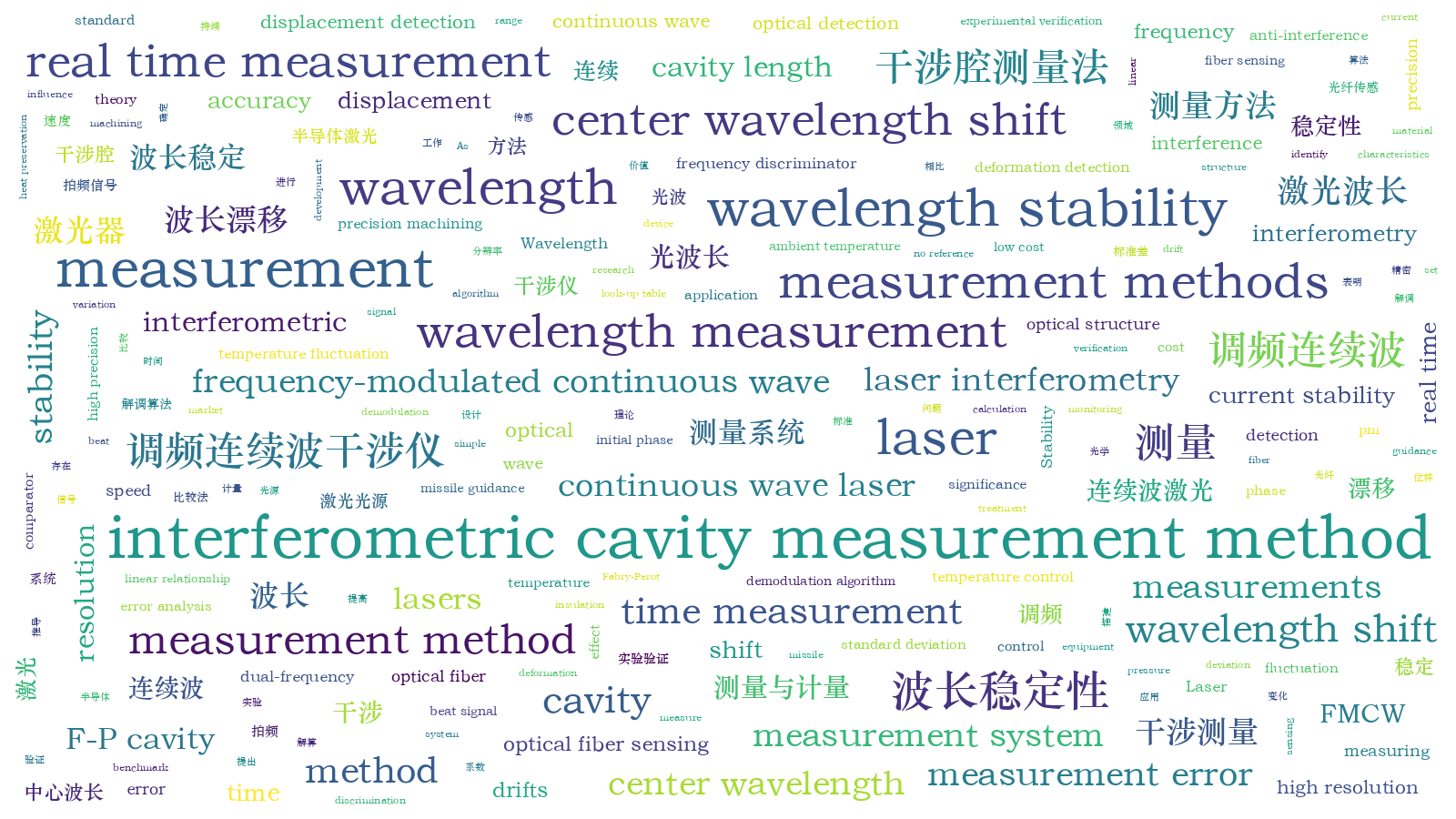一种调频连续波干涉仪激光波长稳定性测量方法  下载: 726次
下载: 726次
With the rapid development of laser interferometry technologies, the industrial production has put forward higher accuracy requirements for precision machining, optical detection, assembly measurement, etc. For example, the displacement detection of components in computer numerical control machine tools, the deformation detection of bridges and dams, and the internal pressure monitoring of missile guidance all need precise measurements. As the benchmark of interferometry, laser wavelength directly affects measurement accuracy, thus measuring the stability of laser wavelength is of great significance for analyzing the accuracy of interferometry. According to the physical phenomena, the existing laser wavelength stability measurement methods can be divided into optical beating method, interference comparator method, and specific wavelength sensitive material characteristics based method. These methods have a high wavelength measurement resolution, but need a reference laser, which inevitably increases the cost of a measuring equipment. Frequency-modulated continuous wave (FMCW) interferometry technology has the advantages of strong anti-interference ability, high measurement accuracy, and the ability to measure distances, displacements, temperatures and other physical quantities. This paper proposes a frequency-modulated continuous wave interferometric cavity measurement method, which has the advantages of short measurement time, no reference laser, simple optical structure, low cost, and high measurement resolution. This method has high application value in the fields of optical fiber sensing and precision interferometry.
In order to realize the measurement of laser wavelength drifts, a method of frequency-modulated continuous wave laser wavelength stability measurement based on interferometric cavity is proposed. Firstly, the measurement theory of wavelength shifts is deduced. When the cavity length is constant, the shift of the initial phase is caused by the average center wavelength shift, which leads to the "displacement" in the form. Second, the interferometric cavity is insulated and damped to reduce the influence of ambient temperature fluctuation on the Fabry-Perot (F-P) cavity, the F-P cavity length is measured by the frequency discrimination method, and the displacement-wavelength shift coefficient is determined. Third, the inverse cosine look-up table method is used to identify the phase of the fixed point of the beat signal to obtain the displacement variation. According to the linear relationship between the displacement and the laser wavelength shift, the wavelength shift is collected in real time. Finally, the measurement system of FMCW interferometric cavity is built for experimental verification and error analysis.
In order to verify the validity and accuracy of wavelength stability measured by the FMCW interferometric cavity, an experimental device is set up (Fig. 5). The insulation stability of the F-P cavity is tested (Fig. 6). The displacement fluctuation of the F-P cavity is within ±3 nm, which shows that the heat preservation treatment effect of the F-P cavity is good. The laser wavelength drift is collected within the error range (99.942100.058 mm) of the F-P cavity length measured by the frequency discriminator method (Fig. 8). The standard deviations of laser wavelength drifts are 0.05812, 0.05809, and 0.05806 pm, respectively, under different cavity lengths. It can be seen that the measurement error of cavity length has no obvious effect on the measurement of laser wavelength stability and can be ignored. The average center wavelength stability of the laser is measured by the FMCW interferometric cavity (Fig. 10). The results show that the average center wavelength stability of the laser is 0.19×10-6, the measurement standard deviation is 0.049 pm, and the actual measurement resolution of the laser wavelength shift is 0.016 pm. Therefore the relative measurement resolution is 1.02×10-8. The comparison with the existing laser wavelength measurement methods (Table 1) is conducted. The relative measurement resolution of four methods is better than 1×10-7, but the FMCW interferometric cavity measurement method greatly shortens the measurement time. It shows that the proposed method is convenient in real time, high in measurement resolution, and fast in measurement speed. Moreover, the laser under temperature control and current stability has good repeatability and stability.
In this paper, a method for measuring laser wavelength stability with the FMCW interferometric cavity is proposed, which uses the advantages of high precision, high resolution, and real time measurement of FMCW interference to solve the quantification problem of laser wavelength stability. By deducing the theory underlying the interferometric cavity measurement method, the demodulation algorithm of wavelength drifts is designed to realize the real time measurement of laser wavelength drifts and effectively improve the measurement resolution of wavelength drifts. The experimental results show that the measurement resolution of wavelength shift of the proposed method is 0.016 pm, the calculation speed of wavelength shifts is up to 50/s, and the measurement time is 0.02 s. Compared with those of the optical beating method and interference comparator method, the measurement speed is greatly improved. The laser shows an average wavelength stability of 0.19×10-6 within 1 h. This stability is better than that of most dual-frequency lasers on the market . The proposed method is of great significance to the research on improving the accuracy of FMCW interferometry and has good application value in the field of laser wavelength stability measurements.
郭媛, 郑刚, 盛启明, 聂梦笛, 白浪, 韩园. 一种调频连续波干涉仪激光波长稳定性测量方法[J]. 中国激光, 2022, 49(4): 0404002. Yuan Guo, Gang Zheng, Qiming Sheng, Mengdi Nie, Lang Bai, Yuan Han. New Method for Measuring Laser Wavelength Stability by Using Frequency-Modulated Continuous Wave Interferometer[J]. Chinese Journal of Lasers, 2022, 49(4): 0404002.







